4-叔辛基苯酚(4-tert-octylphenol, 4-t-OP),简称辛基酚,又名对特辛基苯酚、对叔辛基苯酚、4-特辛基苯酚、对-(1,1,3,3-四甲基丁基)苯酚,是非离子表面活性剂烷基酚聚乙氧基酯(APEOs)的分解产物,也是重要的精细化工生产原料。它广泛应用于制造油溶性辛基酚醛树脂、非离子表面活性剂辛基酚聚乙氧基酯、医药、农药、润滑油抗氧剂、紫外线吸收剂、粘合剂、涂料、增塑剂、除锈剂以及油墨固着剂等。随着4-叔辛基苯酚及APEOs的广泛使用,大量4-叔辛基苯酚进入到江河湖泊等自然水体中,目前已广泛存在于地表水、土壤、沉积物以及水生生物中。此外,Routledge和Sumpter[1]的研究表明,辛基酚为雌性激素最强的烷基酚类化合物,能够干扰动物的内分泌系统,对动物生长、发育和生殖造成危害。Myllymäki等[2]的研究表明,4-叔辛基苯酚是一种亲脂性化合物,可快速被机体吸收并在脂肪组织中累积。因此,存在于水域环境中的辛基酚可在水生动物体内富集,甚至会通过食物链影响人类健康[3]。在欧盟水框架指令中,辛基酚类被列为优先有毒有害物质,其中4-叔辛基苯酚在地表水中的限值为0.1 μg·L-1[4]。2011年,作为一种可能对人体健康产生严重影响的化学品,欧洲化学品管理局已将4-叔辛基苯酚列入高关注化学品(substance of very high concern, SVHC)候选清单。因此,有必要调查环境中4-叔辛基苯酚的污染现状,开展生态风险评估研究,对制定环境风险管控措施具有重要的现实意义。
物种敏感性分布法(SSD)是基于不同物种对某一环境胁迫的敏感性服从一定累积概率分布假设,以统计分布模型来描述不同物种样本对胁迫因素的敏感性差异,实现将单一物种的测试结果外推至生态系统的风险评估方法。该方法广泛应用于生态风险评价、环境质量标准以及环境基准的制定。本研究通过构建4-叔辛基苯酚的急性、慢性物种敏感性分布曲线,在分析4-叔辛基苯酚在我国不同环境介质中的污染现状基础上,评估4-叔辛基苯酚对我国水、沉积物的生态风险,以期为我国4-叔辛基苯酚的生态风险评价与管理提供参考。
1 材料与方法(Materials and methods)
1.1 数据搜集与整理
利用美国环境保护局ECOTOX数据库(http://www.epa.gov/ecotox/)、高产量物质信息系统(HPVIS)(https://ofmpub.epa.gov/oppthpv/hpv_ez.html_menu)、日本现有化学品数据库(JECDB)(https://dra4.nihs.go.jp/mhlw_data/jsp/SearchPageENG.jsp)以及相关文献,参照《淡水水生生物水质基准制定技术指南》[5],毒性数据筛选标准为:急性毒性使用暴露时间≤4 d的毒性数据,慢性毒性使用暴露时间≥21 d的毒性数据。本文共收集到6门12个淡水物种的急性毒性数据(表1),2门8个淡水物种的内分泌干扰效应数据和2门4个其他慢性毒性数据(表2),3门8个海水物种的急性毒性数据(表3)。
1.2 5%危害浓度(HC5)的计算
SSD常用于HC5的估算,即可以保护95%以上的物种时对应的急性浓度/慢性浓度。可以使用sigmaplot、ETX2.0、BurrliOZ等软件工具进行SSD曲线拟合。本文使用SSD generator v1分布拟合工具,该工具为美国环境保护局开发的含有宏的Microsoft Excel模板,输入毒性数据后自动计算累积概率并拟合,输出95%置信限的拟合曲线,同时还给出HC5值与置信限。
1.3 PNEC的计算
在慢性毒性数据缺乏的条件下,预测无效应浓度(predicted no effect concentration, PNEC)的计算可以采用评估因子法、最终急性慢性毒性比(FACR)等方法[12]。Hiki和Iwasaki[13]根据150多个化学品的急慢性毒性数据分析,得出基于慢性毒性数据的HC5值平均为基于急性毒性数据的HC5值的1/10,即慢性HC5=急性HC5/10。
PNEC=HC5/AF,AF为评估因子,取值为2~5[5],本文中AF取4。
对于沉积物PNEC,由于未查到有效的4-叔辛基苯酚沉积物毒性效应数据,参照《化学物质环境与健康危害评估技术导则(试行)》[14],采用相平衡分配法进行估算。
表1 4-叔辛基苯酚(4-t-OP)的淡水急性毒性数据
Table 1 Acute toxicity data of 4-tert-octylphenol (4-t-OP) in freshwater
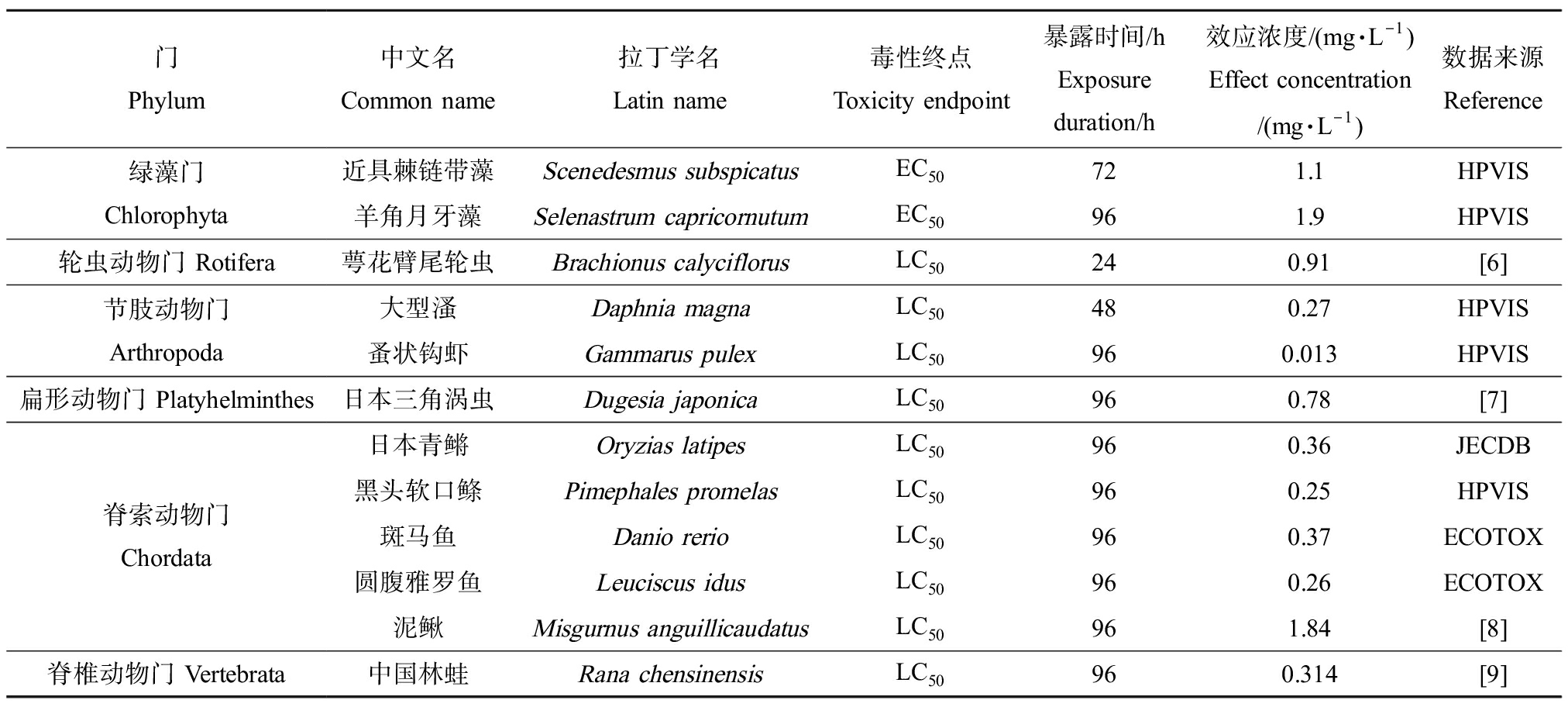
门Phylum中文名Common name拉丁学名Latin name毒性终点Toxicity endpoint暴露时间/hExposure duration/h效应浓度/(mg·L-1)Effect concentration/(mg·L-1)数据来源Reference绿藻门Chlorophyta近具棘链带藻Scenedesmus subspicatusEC50721.1HPVIS羊角月牙藻Selenastrum capricornutumEC50961.9HPVIS轮虫动物门 Rotifera萼花臂尾轮虫Brachionus calyciflorusLC50240.91[6]节肢动物门Arthropoda大型溞Daphnia magnaLC50480.27HPVIS蚤状钩虾Gammarus pulexLC50960.013HPVIS扁形动物门 Platyhelminthes日本三角涡虫Dugesia japonicaLC50960.78[7]脊索动物门Chordata日本青鳉Oryzias latipesLC50960.36JECDB黑头软口鲦Pimephales promelasLC50960.25HPVIS斑马鱼Danio rerioLC50960.37ECOTOX圆腹雅罗鱼Leuciscus idusLC50960.26ECOTOX泥鳅Misgurnus anguillicaudatusLC50961.84[8]脊椎动物门 Vertebrata中国林蛙Rana chensinensisLC50960.314[9]
注:EC50表示半数效应浓度;LC50表示半数致死浓度;HPVIS表示高产量物质信息系统;JECDB表示日本现有化学品数据库;ECOTOX表示美国生态毒理数据库;下同。
Note: EC50 means median effect concentration; LC50 means median lethal concentration; HPVIS means High Production Volume Information System; JECDB means Japan Existing Chemical Database; ECOTOX means ECOTOXicology Knowledgebase; the same as below.
表2 4-叔辛基苯酚的淡水慢性毒性数据
Table 2 Chronic toxicity data of 4-t-OP in freshwater
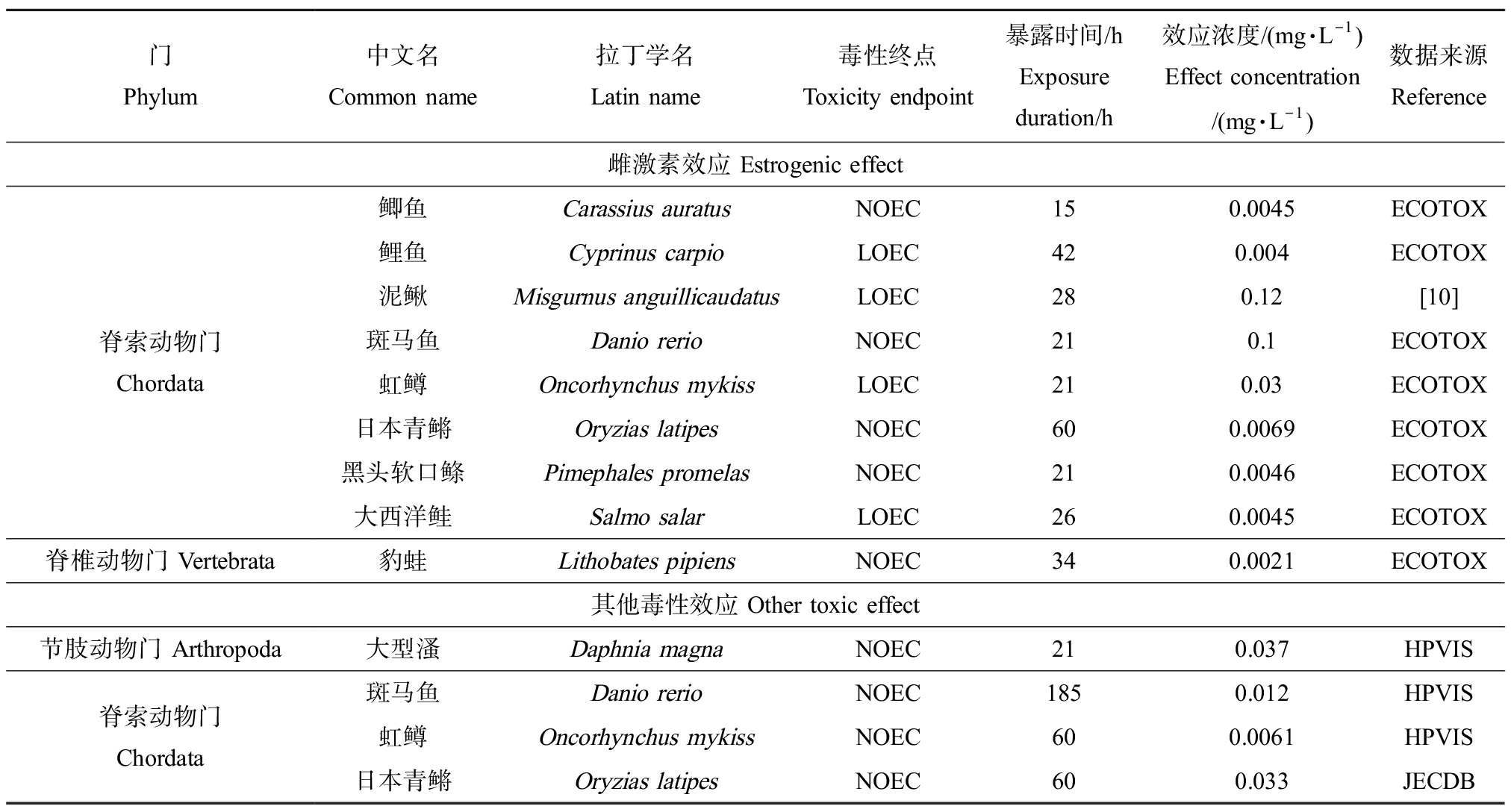
门Phylum中文名Common name拉丁学名Latin name毒性终点Toxicity endpoint暴露时间/hExposure duration/h效应浓度/(mg·L-1)Effect concentration/(mg·L-1)数据来源Reference雌激素效应 Estrogenic effect脊索动物门Chordata鲫鱼Carassius auratusNOEC150.0045ECOTOX鲤鱼Cyprinus carpioLOEC420.004ECOTOX泥鳅Misgurnus anguillicaudatusLOEC280.12[10]斑马鱼Danio rerioNOEC210.1ECOTOX虹鳟Oncorhynchus mykissLOEC210.03ECOTOX日本青鳉Oryzias latipesNOEC600.0069ECOTOX黑头软口鲦Pimephales promelasNOEC210.0046ECOTOX大西洋鲑Salmo salarLOEC260.0045ECOTOX脊椎动物门 Vertebrata豹蛙Lithobates pipiensNOEC340.0021ECOTOX其他毒性效应 Other toxic effect节肢动物门 Arthropoda大型溞Daphnia magnaNOEC210.037HPVIS脊索动物门Chordata斑马鱼Danio rerioNOEC1850.012HPVIS虹鳟Oncorhynchus mykissNOEC600.0061HPVIS日本青鳉Oryzias latipesNOEC600.033JECDB
注:NOEC表示无可观察效应浓度;LOEC表示最低可观察效应浓度。
Note: NOEC means no observed effect concentration; LOEC means lowest observed effect concentration.
1.4 生态风险评价
采用商值法评价4-叔辛基苯酚的生态风险。商值法中风险商(risk quotient, RQ)的计算公式为:
式中:PNEC为预测无效应浓度,MEC为实测环境浓度。本文中,4-叔辛基苯酚的环境浓度数据来源于2010年以后公开发表的文献数据。
当RQ<0.1时,表示化学品对环境存在的风险较低(低风险),当RQ为0.1~1.0时,表明化学品对环境存在一定风险(中风险),需要对相关风险源展开跟踪观察;当RQ超过1.0时,表明化学品对环境存在比较严重的风险(高风险),需要采取相应的风险削减措施。
2 结果(Results)
2.1 我国不同环境介质中的4-叔辛基苯酚暴露浓度
整理了近10年(2010—2020年)文献报道的我国不同地表水水体、沉积物中4-叔辛基苯酚的环境浓度(图1,表5~表7)。
8个湖库报道的4-叔辛基苯酚浓度范围为nd~298.5 ng·L-1,最高检出浓度位于太湖,最低检出浓度位于流溪河水库。五大水系报道的11个数据中,4-叔辛基苯酚浓度范围为nd~749 ng·L-1,最高检出浓度位于珠江水系东江。北京、上海和广州等9个城市的市内河流中4-叔辛基苯酚浓度范围为nd~2 050 ng·L-1,最高检出浓度位于太原市,昆明市检出浓度相对较低。国外的湖库及河流水中4-叔辛基苯酚环境暴露浓度如表4所示,总体处于ng·L-1级水平。
我国太湖、骆马湖2个湖泊沉积物中4-叔辛基苯酚浓度范围为0.909~208.9 ng·g-1。我国珠江、东江等河流沉积物中4-叔辛基苯酚浓度范围为nd~1 605.56 ng·g-1。就河流、湖泊沉积物中4-叔辛基苯酚浓度而言,我国与意大利、丹麦、西班牙等国,除少数点位(中国珠江、中国台湾高雄港)外,总体处于ng·g-1级水平(表5)。
表3 4-叔辛基苯酚的海水急性毒性数据
Table 3 Acute toxicity data of 4-t-OP in seawater
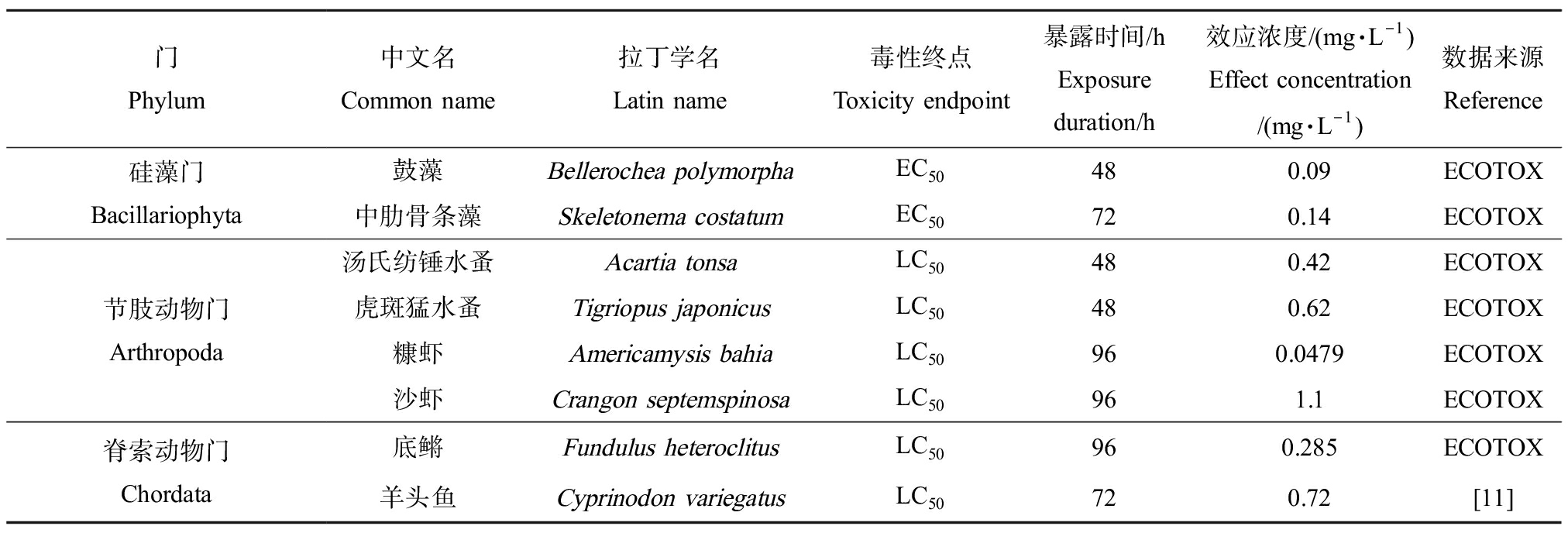
门Phylum中文名Common name拉丁学名Latin name毒性终点Toxicity endpoint暴露时间/hExposure duration/h效应浓度/(mg·L-1)Effect concentration/(mg·L-1)数据来源Reference硅藻门Bacillariophyta鼓藻Bellerochea polymorphaEC50480.09ECOTOX中肋骨条藻Skeletonema costatumEC50720.14ECOTOX节肢动物门Arthropoda汤氏纺锤水蚤Acartia tonsaLC50480.42ECOTOX虎斑猛水蚤Tigriopus japonicusLC50480.62ECOTOX糠虾Americamysis bahiaLC50960.0479ECOTOX沙虾Crangon septemspinosaLC50961.1ECOTOX脊索动物门Chordata底鳉Fundulus heteroclitusLC50960.285ECOTOX羊头鱼Cyprinodon variegatusLC50720.72[11]
表4 国外湖库及河流水中4-叔辛基苯酚环境暴露浓度
Table 4 Environmental exposure concentrations of 4-t-OP in lakes, reservoirs and rivers water of abroad

时间Year位置Site测定浓度/(ng·g-1)Measured concentration/(ng·g-1)平均值/(ng·g-1)Mean/(ng·g-1)数据来源Reference2013奥贡河 River Ogun57.1~68.3 -[38]2009齐比纳河Cybina River<20-[39]2009塞纳河 Seine River1~8114[40]2010—2011伊比利亚河 Iberian Rivernd~85-[41]1999—2009五大湖区与密西西比河上游Great Lakes and Upper Mississippi River Regionsnd~230-[42]
注:-表示原文中未报告数据;nd表示由于低于检测限而无法检出;下同。
Note: -means data was not published in the original articles; nd means not detected; the same as below.
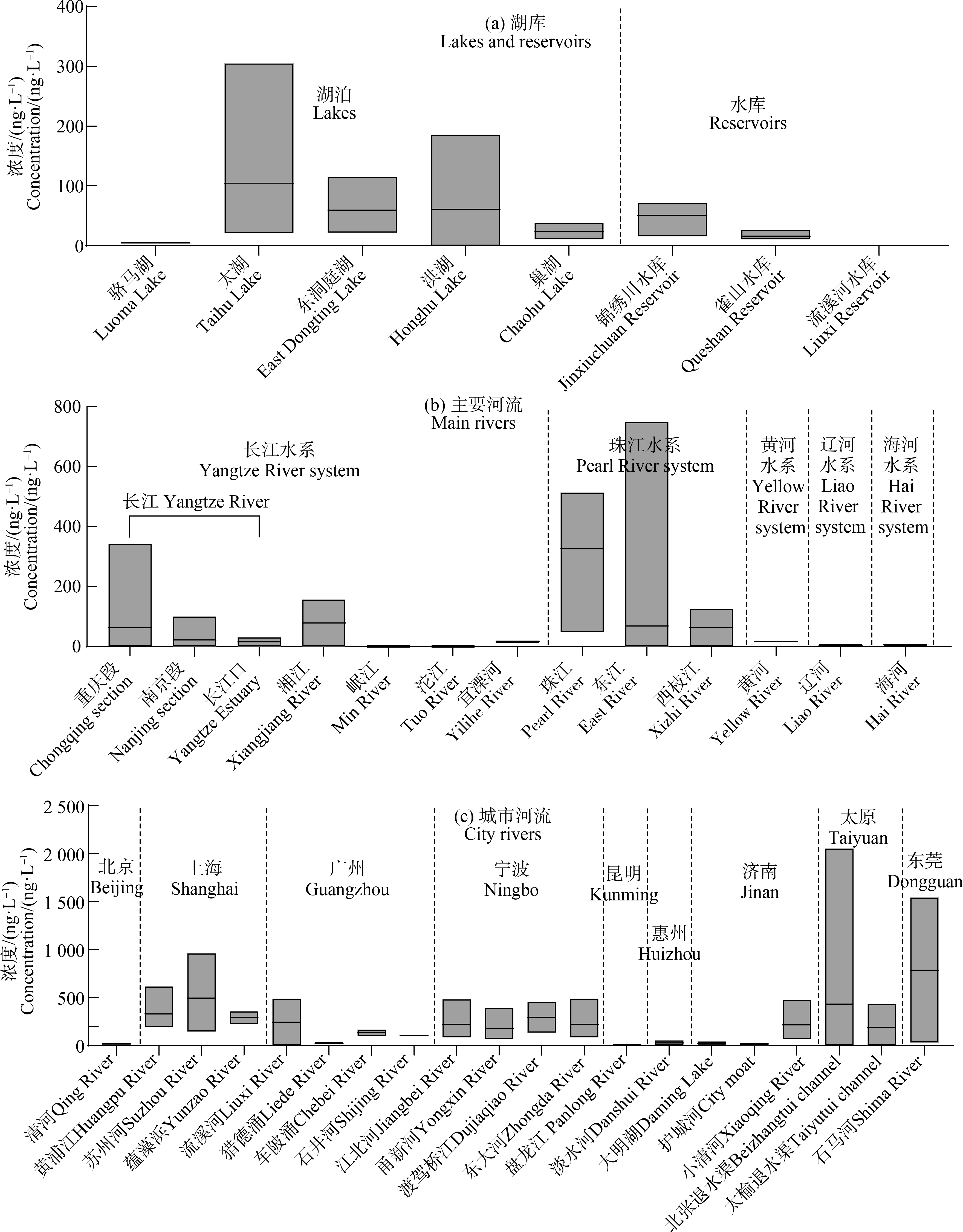
图1 我国湖库及河流水体中4-叔辛基苯酚环境暴露浓度
注:(a) 骆马湖[15],太湖[16],东洞庭湖[17],洪湖[17],巢湖[18],锦绣川水库[19],雀山水库[19],流溪河水库[20];
(b) 长江[21-23],湘江[24],岷江[25],沱江[25],宜溧河[26],珠江[27],东江[28],西枝江[29],黄河[19],辽河[30],海河[30];
(c) 北京[31],上海[32],广州[33],宁波[34],昆明[35],惠州[28],济南[19],太原[36],东莞[28, 37]。
Fig. 1 Environmental exposure concentrations of 4-t-OP in lakes, reservoirs and rivers water of China
Note: (a) Luomahu Lake[15], Taihu Lake[16], East Dongting Lake[17], Honghu Lake[17], Chaohu Lake[18], Jinxiuchuan Reservoir[19],
Queshan Reservoir[19], Liuxi Reservoir[20]; (b) Yangtze River[21-23], Xiangjiang River[24], Min River[25], Tuo River[25], Yilihe River[26],
Pearl River[27], East River[28], Xizhi River[29], Yellow River[19], Liao River[30], Hai River[30]; (c) Beijing[31], Shanghai[32],
Guangzhou[33], Ningbo[34], Kunming[35], Huizhou[28], Ji’nan[19], Taiyuan[36], Dongguan[28, 37].
2篇文献报道了我国海岸线沿海及矛尾海的4-叔辛基苯酚浓度,范围为nd~68.1 ng·L-1,与波兰、法国海水中的4-叔辛基苯酚浓度在相同水平。我国黄海青堆子湾、渤海辽东湾等海洋沉积物中4-叔辛基苯酚浓度范围为nd~12.23 ng·g-1(表6)。
我国6个城市的污水处理厂进出水中4-叔辛基苯酚浓度范围为11.84~1 694 ng·L-1(表7),其中惠州、东莞的印染废水以及宁波市污水处理厂出水中浓度相对较高。与美国、伊朗等国相比,我国与其污水处理厂出水浓度在相同水平,但城市污水处理厂进水最高检出浓度要低于美国芝加哥。
2.2 SSD曲线拟合与PNEC计算
基于表1~表3的急慢性毒性数据,采用SSD generator v1拟合淡水急性、海水急性、淡水慢性SSD曲线如图2所示。
表5 沉积物中4-叔辛基苯酚浓度
Table 5 Concentrations of 4-t-OP in sediment

时间Year位置Site测定浓度/(ng·g-1)Measured concentration/(ng·g-1)平均值/(ng·g-1)Mean/(ng·g-1)数据来源Reference中国China2015太湖 Taihu Lake1.30~209.839.6[16]2016骆马湖 Luoma Lake0.909~5.098-[15]2017珠江 Pearl River56.6~1 605.56692.53[27]2015东江 East Rivernd~76.13.92[28]2015流溪河 Liuxi Rivernd~261-[20]2014盘龙江 Panlong Rivernd~14-[35]2010环滇河流 Rivers around Lake Dianchi2.33~73.32-[43]2010黄浦江 Huangpu River1.03~27.41-[32]2009—2012宁波市内河 Ningbo Inner River 注:LOQ表示定量限;下同。 Note: LOQ means limit of quantitation; the same as below.
表6 海洋环境中4-叔辛基苯酚浓度
Table 6 Concentrations of 4-t-OP in marine environment
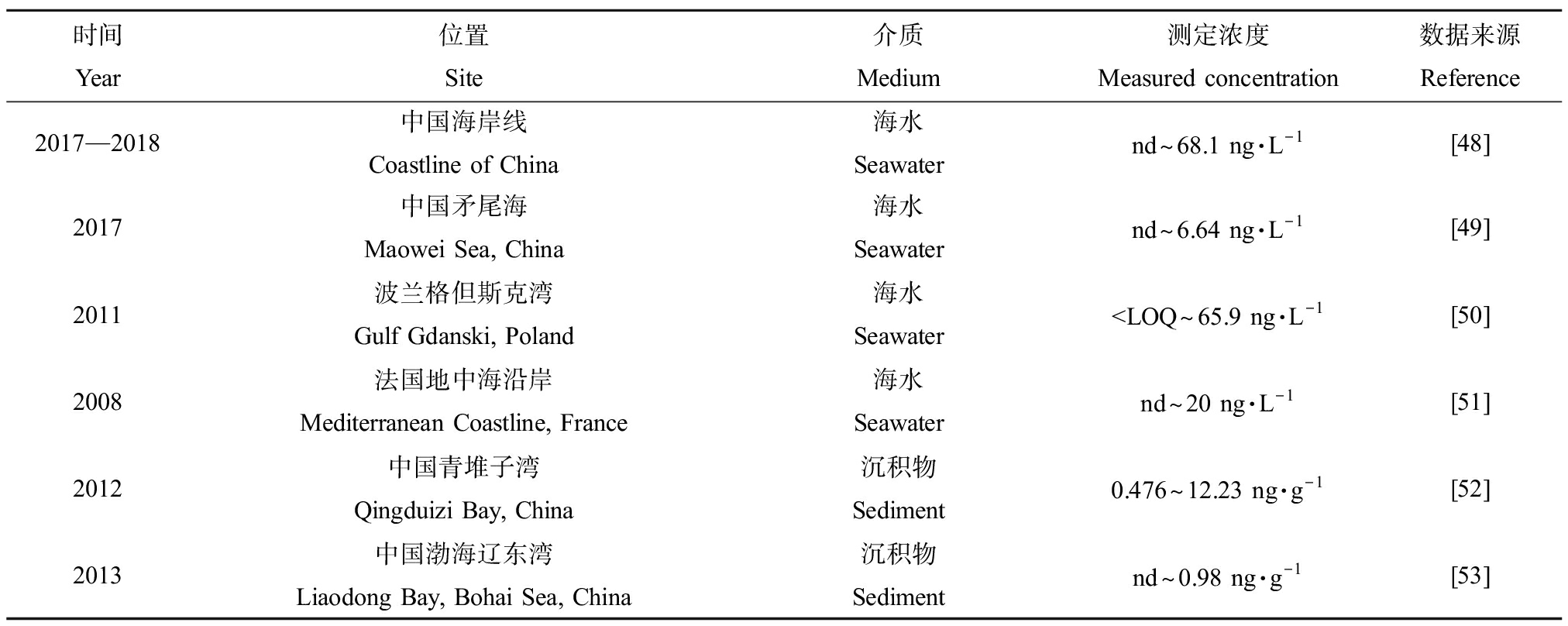
时间Year位置Site介质Medium测定浓度Measured concentration数据来源Reference2017—2018中国海岸线 Coastline of China海水 Seawaternd~68.1 ng·L-1[48]2017中国矛尾海 Maowei Sea, China海水 Seawater nd~6.64 ng·L-1[49]2011波兰格但斯克湾 Gulf Gdanski, Poland海水 Seawater
表7 污水处理厂进出水中4-叔辛基苯酚浓度
Table 7 Concentrations of 4-t-OP in influent and effluent of wastewater treatment plants
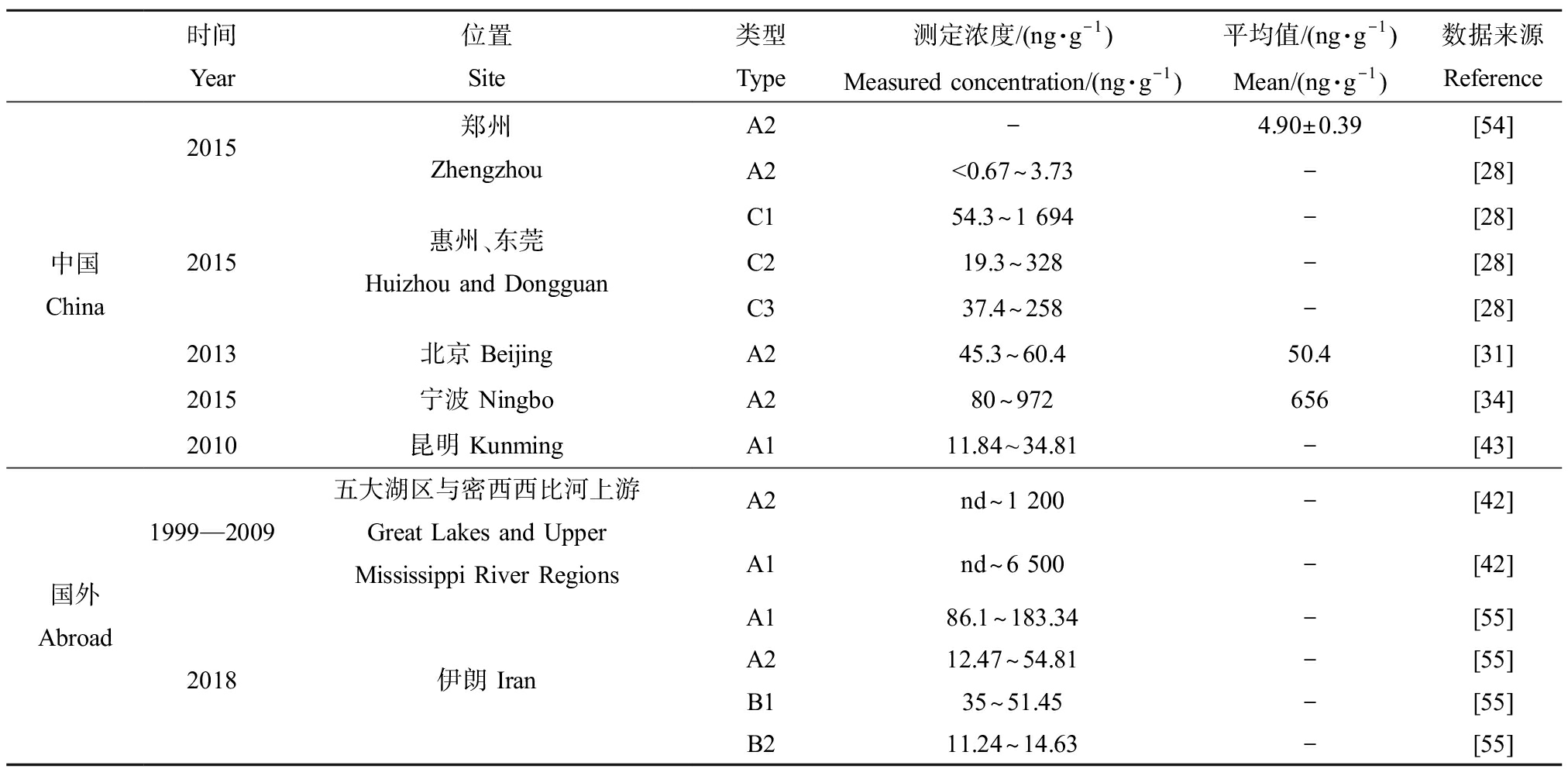
时间Year位置Site类型Type测定浓度/(ng·g-1)Measured concentration/(ng·g-1)平均值/(ng·g-1)Mean/(ng·g-1)数据来源Reference中国China2015郑州 Zhengzhou2015惠州、东莞 Huizhou and Dongguan2013北京 Beijing2015宁波 Ningbo2010昆明 KunmingA2-4.90±0.39[54]A2<0.67~3.73-[28]C154.3~1 694-[28]C219.3~328-[28]C337.4~258-[28]A245.3~60.450.4[31]A280~972656[34]A111.84~34.81-[43]国外Abroad1999—2009五大湖区与密西西比河上游Great Lakes and Upper Mississippi River Regions2018伊朗 IranA2nd~1 200-[42]A1nd~6 500-[42]A186.1~183.34-[55]A212.47~54.81-[55]B135~51.45-[55]B211.24~14.63-[55]
注:A1为城市污水处理厂进水;A2为城市污水处理厂出水;B1为农村污水处理厂进水;B2为农村污水处理厂出水;C1为印染废水;C2为电镀废水;C3为造纸废水。
Note: A1 represents municipal wastewater treatment plants influents; A2 represents municipal wastewater treatment plants effluents; B1 represents rural wastewater treatment plants influents; B2 represents rural wastewater treatment plants effluents; C1 represents dyeing wastewater; C2 represents electroplating wastewater; C3 represents papermaking wastewater.
基于淡水急性SSD曲线(图2(a)),淡水急性HC5=0.037 mg·L-1,95%置信限为0.009~0.147 mg·L-1。基于海水急性SSD曲线(图2(b)),海水急性HC5=0.042 mg·L-1,95%置信限为0.027~0.065 mg·L-1。基于淡水内分泌干扰效应SSD曲线(图2(c)),淡水慢性HC5=0.0008 mg·L-1,95%置信限为0.0002~0.0039 mg·L-1。基于淡水慢性SSD曲线(图2(d)),淡水慢性HC5=0.0022 mg·L-1,95%置信限为0.0015~0.0032 mg·L-1。其他模型参数如表8所示。
由于4-叔辛基苯酚为确定的内分泌干扰物,采用内分泌干扰效应SSD曲线的淡水慢性HC5,AF取值为4,则淡水PNEC=0.20 μg·L-1。
以海水急性HC5值0.042 mg·L-1,采用文献[13]方法推算海水慢性HC5为0.0042 mg·L-1。AF取值为4,则海水PNEC=1.05 μg·L-1。
沉积物生物的危害PNECsed的计算方法参见文献[14]。4-叔辛基苯酚分子量为206.32 g·mol-1,饱和蒸气压为0.001 kPa(20 ℃),水溶解度为19 mg·L-1,正辛醇/水分配系数(logPow)为4.12,吸附系数(Koc)为2 740[56]。其他参数取值为《化学物质环境与健康危害评估技术导则(试行)》[14]中的默认值,估算淡水沉积物生物的危害PNECsed为0.012 mg·kg-1,海水沉积物生物的危害PNECsed为0.063 mg·kg-1。
2.3 基于商值法的生态风险评估
4-叔辛基苯酚在我国淡水地表水中浓度范围为
由表9可知,2010年以来,文献中共有全国28处淡水地表水中4-叔辛基苯酚浓度数据,其中长江水系(太湖、长江)、珠江水系(珠江、东江)4个地表水部分点位为高风险,且珠江水系的风险相对较高。9个城市中上海、广州、宁波、济南、太原和东莞6个城市河流部分点位为高风险。总体而言,28处淡水地表水高风险点位占比为35.7%。10处有数据报道的淡水沉积物9处为低风险,1个点位为中风险。由表10可知,我国海洋环境中海水与沉积物中的4-叔辛基苯酚生态风险为低风险。
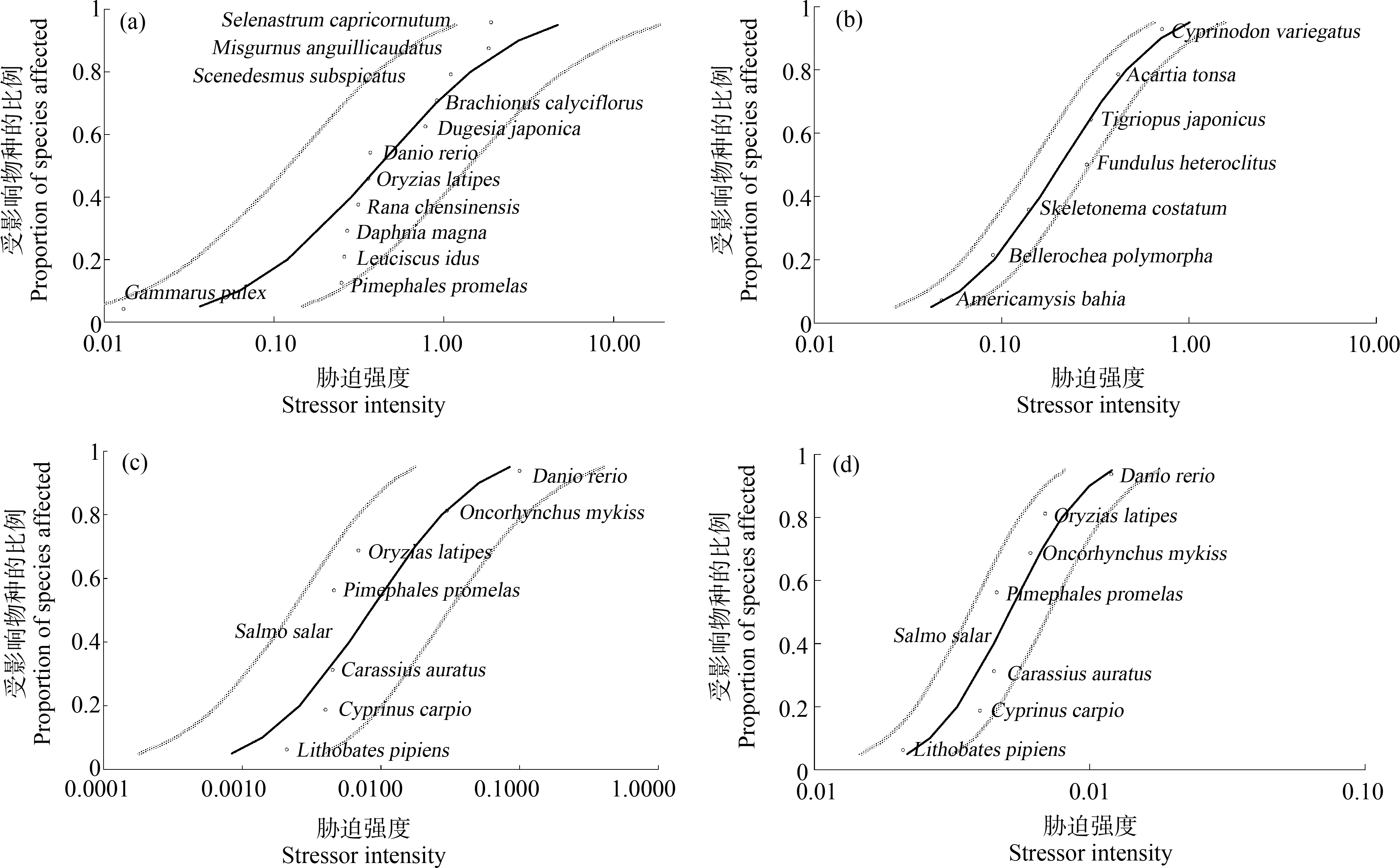
图2 4-叔辛基苯酚的急慢性物种敏感性分布(SSD)曲线
注:(a)淡水急性毒性;(b)海水急性毒性;(c)淡水内分泌干扰效应;(d)淡水内分泌干扰效应+其他慢性毒性。
Fig. 2 Species sensitivity distribution (SSD) curves for acute and chronic toxicity of 4-t-OP
Note: (a) Acute toxicity to freshwater organisms; (b) Acute toxicity to marine organisms; (c) Endocrine disrupting effects for
freshwater organisms; (d) Endocrine disrupting effects and other chronic toxicity to freshwater organisms.
表8 拟合SSD曲线方程参数
Table 8 Equation parameter values of SSD curves

类别Category分布函数Distribution function斜率Slope截距InterceptR2MSE淡水急性 Acute toxicity to freshwater organismslog-normal1.5615.5960.8200.194海水急性 Acute toxicity to marine organismslog-normal2.2846.6370.9740.031淡水内分泌干扰效应Endocrine disrupting effects for freshwater organismslog-normal1.6418.4030.8250.204淡水慢性 Chronic toxicity to freshwater organismslog-normal4.42415.1350.9170.097
注:R2表示决定系数;MSE表示均方误差。
Note:R2 means coefficient of determination; MSE means mean-square error.
3 讨论(Discussion)
28处淡水地表水环境调查点涵盖了我国七大水系中的长江水系、珠江水系、黄河水系、辽河水系和海河水系和9个城市河流,海水地表水环境调查点涵覆盖了我国近海区域。综合淡水与海水地表水中4-叔辛基苯酚的检出浓度,目前整体处于ng·L-1水平,与国外相关文献资料报道的检出浓度基本在相同水平。值得注意的是,检出浓度相对较低的黄河水系、辽河水系、海河水系,数据来源的文献相对偏少,调查时间较早(2010—2011年),相关数据可能不能代表这3个水系中4-叔辛基苯酚目前的污染现状。此外,从宁波2个污水处理厂出水中4-叔辛基苯酚浓度来看,平均浓度高达597 ng·L-1和716 ng·L-1。多项研究表明,污水处理厂出水是环境中内分泌干扰物的重要来源之一[57-58]。为了遏制我国水环境中4-叔辛基苯酚的浓度日趋升高,有必要在《城镇污水处理厂污染物排放标准》中增加针对4-叔辛基苯酚的排放标准。
足够的生态毒性数据和环境暴露浓度数据是采用物种敏感性分布法开展生态风险评估的基础。经济合作发展组织以及澳大利亚水质标准、我国的淡水水质基准中推荐的最小数量为5个,其他研究或政府指导文件从8到10个不等。本文中的12个淡水物种、8个海水物种的急性毒性数据、8个淡水物种的慢性毒性数据,符合生态毒性数据数量的要求。需要指出的是,用于构建急性SSD曲线的12个淡水物种中,除黑头软口鲦、斑马鱼外,其他生物均为本土物种或在我国的水生态系统中也有分布。用于构建慢性SSD曲线的9个淡水物种中,除豹蛙外,其他生物均为本土物种或国际通用物种。用于构建急性海水SSD曲线的8个海水物种中,中肋骨条藻、虎斑猛水蚤以及沙虾在我国近海均有分布。因此,本文采用SSD法得到的淡水、海水以及沉积物的PNEC可以为我国的水环境4-叔辛基苯酚的生态风险评估提供参考。
表9 我国淡水环境中4-叔辛基苯酚生态风险
Table 9 Ecological risk of 4-t-OP in freshwater of China
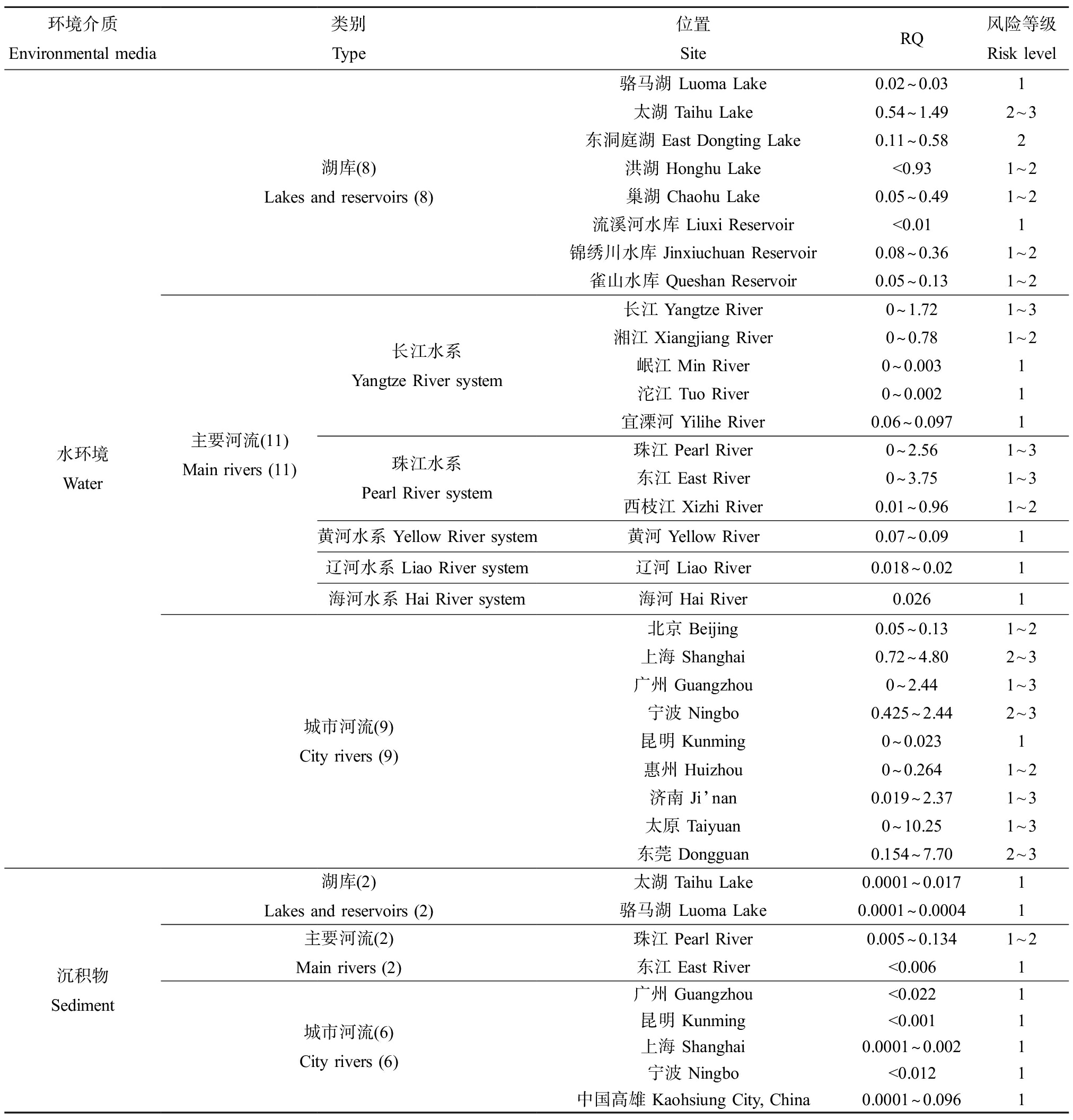
环境介质Environmental media类别Type位置SiteRQ风险等级Risk level水环境Water湖库(8)Lakes and reservoirs (8)主要河流(11)Main rivers (11)长江水系Yangtze River system珠江水系Pearl River system黄河水系 Yellow River system辽河水系 Liao River system海河水系 Hai River system城市河流(9)City rivers (9)骆马湖 Luoma Lake0.02~0.031太湖 Taihu Lake0.54~1.492~3东洞庭湖 East Dongting Lake0.11~0.582洪湖 Honghu Lake<0.931~2巢湖 Chaohu Lake0.05~0.491~2流溪河水库 Liuxi Reservoir<0.011锦绣川水库 Jinxiuchuan Reservoir0.08~0.361~2雀山水库 Queshan Reservoir0.05~0.131~2长江 Yangtze River0~1.721~3湘江 Xiangjiang River0~0.781~2岷江 Min River0~0.0031沱江 Tuo River0~0.0021宜溧河 Yilihe River0.06~0.0971珠江 Pearl River0~2.561~3东江 East River0~3.751~3西枝江 Xizhi River0.01~0.961~2黄河 Yellow River0.07~0.091辽河 Liao River0.018~0.021海河 Hai River0.0261北京 Beijing0.05~0.131~2上海 Shanghai0.72~4.802~3广州 Guangzhou0~2.441~3宁波 Ningbo0.425~2.442~3昆明 Kunming0~0.0231惠州 Huizhou0~0.2641~2济南 Ji’nan0.019~2.371~3太原 Taiyuan0~10.251~3东莞 Dongguan0.154~7.702~3沉积物Sediment湖库(2)Lakes and reservoirs (2)主要河流(2)Main rivers (2)城市河流(6)City rivers (6)太湖 Taihu Lake0.0001~0.0171骆马湖 Luoma Lake0.0001~0.00041珠江 Pearl River0.005~0.1341~2东江 East River<0.0061广州 Guangzhou<0.0221昆明 Kunming<0.0011上海 Shanghai0.0001~0.0021宁波 Ningbo<0.0121中国高雄 Kaohsiung City, China0.0001~0.0961
注:RQ表示风险商;风险等级列中,1代表低风险,2代表中风险,3代表高风险。
Note: RQ stands for risk quotient; in column of risk level, 1 represents low risk, 2 represents medium risk, and 3 represents high risk.
表10 我国海水环境中的4-叔辛基苯酚生态风险
Table 10 Ecological risk of 4-t-OP in seawater of China

环境介质Environmental media位置SiteRQ风险等级Risk level海水Seawater中国海岸线 Coastline of China<0.065低风险 Low risk中国矛尾海 Maowei Sea, China<0.006低风险 Low risk沉积物Sediment中国青堆子湾 Qingduizi Bay, China<0.0002低风险 Low risk中国渤海辽东湾 Liaodong Bay, Bohai Sea, China<0.00001低风险 Low risk
欧盟水框架指令中4-叔辛基苯酚在地表水中的限值为0.1 μg·L-1,该值基于最敏感物种虹鳟(Oncorhynchus mykiss)的慢性毒性值60 d-NOEC=6.1 μg·L-1以及评估因子AF=50计算而来[59]。基于表4的数据,目前已知的本土物种中最敏感物种为鲤鱼(Cyprinus carpio),42 d-NOEC=4 μg·L-1。本研究中,基于最敏感物种的慢性毒性以及其他生物基于内分泌干扰效应的慢性毒性值采用SSD法计算的PNEC(0.2 μg·L-1)与欧盟采用评估因子法的结果(0.1 μg·L-1)处于同一数量级。评估因子法因其简单易行,广泛应用于环境污染物的生态风险评估以及水质基准制订,近年来因其不确定性,不准确性,过度保守等缺点而受到批评[60]。物种敏感性分布法充分利用了获得的所有物种的毒性数据,从某种程度上来说可以代表整个生态系统,其结果更具有参考性。
综上所述,利用ECOTOX数据库、高产量物质信息系统HPVIS和已发表文献中4-叔辛基苯酚的急慢性毒性数据,以及2010年以来我国8个湖库、11条主要河流、9个城市市内河流以及我国近海的水体和沉积物中4-叔辛基苯酚的浓度数据,采用SSD法计算了淡水、海水以及沉积物的PNEC,并采用商值法进行了生态风险评价。得出以下结论:
2010年以来,4-叔辛基苯酚在我国不同水环境介质中的浓度范围,淡水地表水中为
采用SSD法计算淡水PNEC=0.20 μg·L-1,海水PNEC=1.05 μg·L-1。采用平衡分配法得到淡水沉积物PNEC=0.012 mg·kg-1,海水PNEC=0.063 mg·kg-1。
基于全国共28处淡水地表水中4-叔辛基苯酚环境暴露浓度数据,长江水系(太湖、长江)、珠江水系(珠江、东江)4个地表水部分点位为高风险,且珠江水系的风险相对较高。9个城市中上海、广州、宁波、济南、太原和东莞6个城市河流部分点位为高风险。总体而言,28处淡水地表水高风险点位占比为35.7%。10处有数据报道的淡水沉积物9处为低风险,1处为中风险。海水及海洋沉积物均为低风险。4-叔辛基苯酚对我国淡水环境的影响应该引起环境管理部门的重视。
通讯作者简介:王蕾(1983—),女,博士,副研究员,主要研究方向为化学品生态危害评估。
共同通讯作者简介:刘济宁(1977—),男,博士,研究员,主要研究方向为化学品风险评估。
[1] Routledge E J, Sumpter J P. Structural features of alkylphenolic chemicals associated with estrogenic activity [J]. Journal of Biological Chemistry, 1997, 272(6): 3280-3288
[2] Myllymäki S A, Karjalainen M, Haavisto T E, et al. Infantile 4-tert-octylphenol exposure transiently inhibits rat ovarian steroidogenesis and steroidogenic acute regulatory protein (StAR) expression [J]. Toxicology and Applied Pharmacology, 2005, 207(1): 59-68
[3] Ying G G, Williams B, Kookana R. Environmental fate of alkylphenols and alkylphenol ethoxylates: A review [J]. Environment International, 2002, 28(3): 215-226
[4] European Union. Directive 2013/39/EU of the European Parliament and of the Council of 12 August 2013 amending Directives 2000/60/EC and 2008/105/EC as regards priority substances in the field of water policy [S]. European Union, 2013
[5] 中华人民共和国环境保护部. 淡水水生生物水质基准制定技术指南: HJ 831—2017[S]. 北京: 中国环境出版社, 2017
[6] 李若男, 王再兴, 夏洋, 等. 辛基酚对萼花臂尾轮虫毒性效应的研究[J]. 水产养殖, 2019, 40(10): 20-24
Li R N, Wang Z X, Xia Y, et al. Study of the toxicity effect of octylphenol for rotifer Brachionus calyciflorus [J]. Journal of Aquaculture, 2019, 40(10): 20-24 (in Chinese)
[7] Li M H. Survival, mobility, and membrane-bound enzyme activities of freshwater planarian, Dugesia japonica, exposed to synthetic and natural surfactants [J]. Environmental Toxicology and Chemistry, 2012, 31(4): 843-850
[8] 雷忻, 任立松, 薛浩, 等. 辛基酚对泥鳅的毒性作用及鳃、肝的组织学影响[J]. 西北农林科技大学学报: 自然科学版, 2013, 41(8): 13-18
Lei X, Ren L S, Xue H, et al. Acute and histological toxicity of octylphenol to gill and liver of Misgurnus anguillicaudatus [J]. Journal of Northwest A & F University: Natural Science Edition, 2013, 41(8): 13-18 (in Chinese)
[9] 洪燕燕, 张育辉. 辛基酚对中国林蛙蝌蚪生长发育的毒性效应[J]. 生态毒理学报, 2010, 5(3): 343-350
Hong Y Y, Zhang Y H. Toxicity effects of octylphenol on growth and development of tadpoles (Rana chensinensis) [J]. Asian Journal of Ecotoxicology, 2010, 5(3): 343-350 (in Chinese)
[10] 雷忻, 关鹏周, 贾向荣, 等. 辛基酚胁迫对雄性泥鳅抗氧化酶及卵黄蛋白原的影响[J]. 生态学报, 2015, 35(8): 2502-2508
Lei X, Guan P Z, Jia X R, et al. Incidence of antioxidant enzymes and vitellogenin induced in male loach (Misgurnus anguillicaudatus) exposed to octylphenol [J]. Acta Ecologica Sinica, 2015, 35(8): 2502-2508 (in Chinese)
[11] Karels A A, Manning S, Brouwer T H, et al. Reproductive effects of estrogenic and antiestrogenic chemicals on sheepshead minnows (Cyprinodon variegatus) [J]. Environmental Toxicology and Chemistry, 2003, 22(4): 855-865
[12] 汪贞, 杨先海, 范德玲, 等. 应用物种敏感性分布评估三氯卡班对我国淡水环境的生态风险[J]. 生态与农村环境学报, 2017, 33(10): 921-927
Wang Z, Yang X H, Fan D L, et al. Ecological risk assessment of triclocarban in fresh water of China by species sensitivity distribution [J]. Journal of Ecology and Rural Environment, 2017, 33(10): 921-927 (in Chinese)
[13] Hiki K, Iwasaki Y. Can we reasonably predict chronic species sensitivity distributions from acute species sensitivity distributions? [J]. Environmental Science & Technology, 2020, 54(20): 13131-13136
[14] 中华人民共和国生态环境部. 化学物质环境与健康危害评估技术导则(试行)[S]. 北京: 中华人民共和国生态环境部, 2020
[15] Dan-Liu, Wu S M, Xu H Z, et al. Distribution and bioaccumulation of endocrine disrupting chemicals in water, sediment and fishes in a shallow Chinese freshwater lake: Implications for ecological and human health risks [J]. Ecotoxicology and Environmental Safety, 2017, 140: 222-229
[16] Liu D, Liu J N, Guo M, et al. Occurrence, distribution, and risk assessment of alkylphenols, bisphenol A, and tetrabromobisphenol A in surface water, suspended particulate matter, and sediment in Taihu Lake and its tributaries [J]. Marine Pollution Bulletin, 2016, 112(1-2): 142-150
[17] Yang Y Y, Cao X H, Zhang M M, et al. Occurrence and distribution of endocrine-disrupting compounds in the Honghu Lake and East Dongting Lake along the Central Yangtze River, China [J]. Environmental Science and Pollution Research International, 2015, 22(22): 17644-17652
[18] Shan X M, Shen D H, Wang B S, et al. Simultaneous determination of bisphenols and alkylphenols in water by solid phase extraction and ultra performance liquid chromatography-tandem mass spectrometry [J]. Biomedical and Environmental Sciences, 2014, 27(6): 471-474
[19] Yang X Y, Liu M R, Wang Z P, et al. Determination of 4-tert-octylphenol in surface water samples of Jinan in China by solid phase extraction coupled with GC-MS [J]. Journal of Environmental Sciences, 2013, 25(8): 1712-1717
[20] Peng F J, Pan C G, Zhang M, et al. Occurrence and ecological risk assessment of emerging organic chemicals in urban rivers: Guangzhou as a case study in China [J]. The Science of the Total Environment, 2017, 589: 46-55
[21] 卓丽, 许榕发, 石运刚, 等. 重庆长江流域水体中8种典型环境雌激素污染特征[J]. 生态毒理学报, 2020, 15(3): 149-157
Zhuo L, Xu R F, Shi Y G, et al. Estrogens in surface water of the Yangtze River in Chongqing section [J]. Asian Journal of Ecotoxicology, 2020, 15(3): 149-157 (in Chinese)
[22] Liu Y H, Zhang S H, Ji G X, et al. Occurrence, distribution and risk assessment of suspected endocrine-disrupting chemicals in surface water and suspended particulate matter of Yangtze River (Nanjing section) [J]. Ecotoxicology and Environmental Safety, 2017, 135: 90-97
[23] Du X, Li X H, Luo T L, et al. Occurrence and aquatic ecological risk assessment of typical organic pollutants in water of Yangtze River Estuary [J]. Procedia Environmental Sciences, 2013, 18: 882-889
[24] Luo Z F, Tu Y, Li H P, et al. Endocrine-disrupting compounds in the Xiangjiang River of China: Spatio-temporal distribution, source apportionment, and risk assessment [J]. Ecotoxicology and Environmental Safety, 2019, 167: 476-484
[25] 张永丽, 梁大山, 郭洪光, 等. 岷江、沱江流域丰水期典型雌激素的分布特征研究[J]. 中国农村水利水电, 2016(7): 34-37, 42
[26] 王志强, 张依章, 张远, 等. 太湖流域宜溧河酚类内分泌干扰物的空间分布及风险评价[J]. 环境科学研究, 2012, 25(12): 1351-1358
Wang Z Q, Zhang Y Z, Zhang Y, et al. Spatial distribution and risk assessment of typical EDCs in Yili River of Taihu Basin [J]. Research of Environmental Sciences, 2012, 25(12): 1351-1358 (in Chinese)
[27] 刘畅伶, 张文强, 单保庆. 珠江口典型河段内分泌干扰物的空间分布及风险评价[J]. 环境科学学报, 2018, 38(1): 115-124
Liu C L, Zhang W Q, Shan B Q. Spatial distribution and risk assessment of endocrine disrupting chemicals in the typical station of Pearl River [J]. Acta Scientiae Circumstantiae, 2018, 38(1): 115-124 (in Chinese)
[28] Zhao J L, Huang Z, Zhang Q Q, et al. Distribution and mass loads of xenoestrogens bisphenol A, 4-nonylphenol, and 4-tert-octylphenol in rainfall runoff from highly urbanized regions: A comparison with point sources of wastewater [J]. Journal of Hazardous Materials, 2021, 401: 123747
[29] Lv Y Z, Yao L, Wang L, et al. Bioaccumulation, metabolism, and risk assessment of phenolic endocrine disrupting chemicals in specific tissues of wild fish [J]. Chemosphere, 2019, 226: 607-615
[30] Jiang W W, Yan Y, Ma M, et al. Assessment of source water contamination by estrogenic disrupting compounds in China [J]. Journal of Environmental Sciences, 2012, 24(2): 320-328
[31] Liu R Z, Ruan T, Song S J, et al. Determination of synthetic phenolic antioxidants and relative metabolites in sewage treatment plant and recipient river by high performance liquid chromatography-electrospray tandem mass spectrometry [J]. Journal of Chromatography A, 2015, 1381: 13-21
[32] Wu M H, Wang L, Xu G, et al. Seasonal and spatial distribution of 4-tert-octylphenol, 4-nonylphenol and bisphenol A in the Huangpu River and its tributaries, Shanghai, China [J]. Environmental Monitoring and Assessment, 2013, 185(4): 3149-3161
[33] 樊静静, 王赛, 唐金鹏, 等. 广州市流溪河水体中6种内分泌干扰素时空分布特征与环境风险[J]. 环境科学, 2018, 39(3): 1053-1064
Fan J J, Wang S, Tang J P, et al. Spatio-temporal patterns and environmental risk of endocrine disrupting chemicals in the Liuxi River [J]. Environmental Science, 2018, 39(3): 1053-1064 (in Chinese)
[34] Cheng J R, Wang K, Yu J, et al. Distribution and fate modeling of 4-nonylphenol, 4-t-octylphenol, and bisphenol A in the Yong River of China [J]. Chemosphere, 2018, 195: 594-605
[35] 王彬, 董发勤, 谌书, 等. 盘龙江水及沉积物中酚类EDCs的污染特征及源解析[J]. 安全与环境学报, 2016, 16(1): 288-294
Wang B, Dong F Q, Chen S, et al. Analysis of the sources of phenolic pollution in situ and features with endocrine disrupting compounds in Panlong River [J]. Journal of Safety and Environment, 2016, 16(1): 288-294 (in Chinese)
[36] 刘敏, 张彩香, 廖小平, 等. 污灌区地表水中辛基酚、壬基酚及其前体的分布特征[J]. 环境化学, 2014, 33(7): 1101-1106
Liu M, Zhang C X, Liao X P, et al. Distribution characteristics of octylphenol, nonylphenol and nonylphenol polyethoxylates in surface water of sewage irrigation area [J]. Environmental Chemistry, 2014, 33(7): 1101-1106 (in Chinese)
[37] Chen C E, Liu Y S, Dunn R, et al. A year-long passive sampling of phenolic endocrine disrupting chemicals in the East River, South China [J]. Environment International, 2020, 143: 105936
[38] Oketola A A, Fagbemigun T K. Determination of nonylphenol, octylphenol and bisphenol-A in water and sediments of two major rivers in Lagos, Nigeria [J]. Journal of Environmental Protection, 2013, 4(7): 38-45
![]() T, Rydlichowski R, et al. Concentrations of endocrine disrupting alkylphenols and their mono- and diethoxylates in sediments and water from artificial lake Malta in Poland [J]. Tenside Surfactants Detergents, 2010, 47(4): 222-227
T, Rydlichowski R, et al. Concentrations of endocrine disrupting alkylphenols and their mono- and diethoxylates in sediments and water from artificial lake Malta in Poland [J]. Tenside Surfactants Detergents, 2010, 47(4): 222-227
[40] Cladière M, Gasperi J, Gilbert S, et al. Alkylphenol ethoxylates and bisphenol A in surface water within a heavily urbanized area, such as Paris [M]. Southampton, UK: WIT Press, 2010: 131-142
[41] Gorga M, Insa S, Petrovic M, et al. Occurrence and spatial distribution of EDCs and related compounds in waters and sediments of Iberian rivers [J]. The Science of the Total Environment, 2015, 503-504: 69-86
[42] Barber L B, Loyo-Rosales J E, Rice C P, et al. Endocrine disrupting alkylphenolic chemicals and other contaminants in wastewater treatment plant effluents, urban streams, and fish in the Great Lakes and Upper Mississippi River Regions [J]. The Science of the Total Environment, 2015, 517: 195-206
[43] 王彬. 酚类环境内分泌干扰物分析方法及滇池水系污染特征研究[D]. 昆明: 昆明理工大学, 2012: 107-109
Wang B. Analytical method of phenolic endocrine disrupting chemicals and their pollution characteristics in Dianchi Lake catchment [D]. Kunming: Kunming University of Science and Technology, 2012: 107-109 (in Chinese)
[44] 程军蕊, 徐继荣, 刘英, 等. 宁波市内河几种酚类环境激素的污染状况及分布特征[J]. 宁波大学学报: 理工版, 2014, 27(1): 103-108
Cheng J R, Xu J R, Liu Y, et al. Pollution and distribution of phenolic endocrine disruptors in water columns and sediments in Ningbo inner river [J]. Journal of Ningbo University: Natural Science & Engineering Edition, 2014, 27(1): 103-108 (in Chinese)
[45] Dong C D, Chen C W, Chen C F. Seasonal and spatial distribution of 4-nonylphenol and 4-tert-octylphenol in the sediment of Kaohsiung Harbor, Taiwan [J]. Chemosphere, 2015, 134: 588-597
[46] Luigi V, Giuseppe M, Claudio R. Emerging and priority contaminants with endocrine active potentials in sediments and fish from the River Po (Italy) [J]. Environmental Science and Pollution Research International, 2015, 22(18): 14050-14066
[47] Danish Environmental Protection Agency. Survey of alkylphenols and alkylphenol ethoxylates [R]. Copenhagen, Denmark: Danish Environmental Protection Agency, 2013
[48] Lu J, Zhang C, Wu J, et al. Seasonal distribution, risks, and sources of endocrine disrupting chemicals in coastal waters: Will these emerging contaminants pose potential risks in marine environment at continental-scale? [J]. Chemosphere, 2020, 247: 125907
[49] Zheng R H, Fang C, Hong F K, et al. Developing and applying a classification system for ranking the biological effects of endocrine disrupting chemicals on male rockfish Sebastiscus marmoratus in the Maowei Sea, China [J]. Marine Pollution Bulletin, 2021, 163: 111931
[50] Staniszewska M, Falkowska L, Grabowski P, et al. Bisphenol A, 4-tert-octylphenol, and 4-nonylphenol in the gulf of Gdańsk (southern Baltic) [J]. Archives of Environmental Contamination and Toxicology, 2014, 67(3): 335-347
[51] Munaron D, Tapie N, Budzinski H, et al. Pharmaceuticals, alkylphenols and pesticides in Mediterranean coastal waters: Results from a pilot survey using passive samplers [J]. Estuarine, Coastal and Shelf Science, 2012, 114: 82-92
[52] Wang L L, Yang X L, Zhang A G, et al. Distribution patterns and ecological risk of endocrine-disrupting chemicals at Qingduizi Bay (China): A preliminary survey in a developing maricultured bay [J]. Marine Pollution Bulletin, 2019, 146: 915-920
[53] Yuan X T, Yang X L, Zhang A G, et al. Distribution, potential sources and ecological risks of two persistent organic pollutants in the intertidal sediment at the Shuangtaizi Estuary, Bohai Sea of China [J]. Marine Pollution Bulletin, 2017, 114(1): 419-427
[54] Sun J, Wang J, Zhang R, et al. Comparison of different advanced treatment processes in removing endocrine disruption effects from municipal wastewater secondary effluent [J]. Chemosphere, 2017, 168: 1-9
[55] Bina B, Mohammadi F, Amin M M, et al. Determination of 4-nonylphenol and 4-tert-octylphenol compounds in various types of wastewater and their removal rates in different treatment processes in nine wastewater treatment plants of Iran [J]. Chinese Journal of Chemical Engineering, 2018, 26(1): 183-190
[56] European Chemicals Agency. SVHC support document: 4-(1,1,3,3-tetramethylbutyl)phenol, 4-tert-octylphenol [R]. Helsinki, Finland: European Chemicals Agency, 2011
[57] 马德华, 张洪波, 魏建建, 等. 污水处理厂出水中抗雄激素样化合物控制的优先性研究[J]. 生态毒理学报, 2018, 13(6): 144-156
Ma D H, Zhang H B, Wei J J, et al. Control priority order of the environmental antiandrogens in effluents of wastewater treatment plants [J]. Asian Journal of Ecotoxicology, 2018, 13(6): 144-156 (in Chinese)
[58] 聂亚峰, 强志民, 张鹤清, 等. 内分泌干扰物在城市污水处理厂中的行为和归趋: 综述[J]. 环境科学学报, 2011, 31(7): 1352-1362
Nie Y F, Qiang Z M, Zhang H Q, et al. Behavior and fate of endocrine disrupting chemicals in municipal sewage treatment plants: A review [J]. Acta Scientiae Circumstantiae, 2011, 31(7): 1352-1362 (in Chinese)
[59] European Commission. Common implementation strategy for the water framework directive: Environmental quality standards (EQS): Substance data sheet: Priority substance No. 25 [R]. Brussels: European Commission, 2005
[60] Okonski A I, MacDonald D B, Potter K, et al. Deriving predicted no-effect concentrations (PNECs) using a novel assessment factor method [J]. Human and Ecological Risk Assessment: An International Journal, 2021, 27(6): 1613-1635